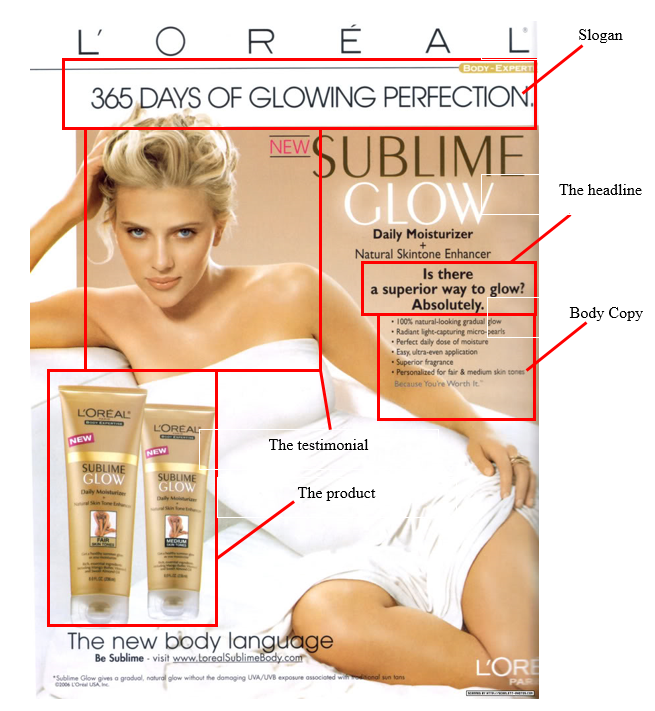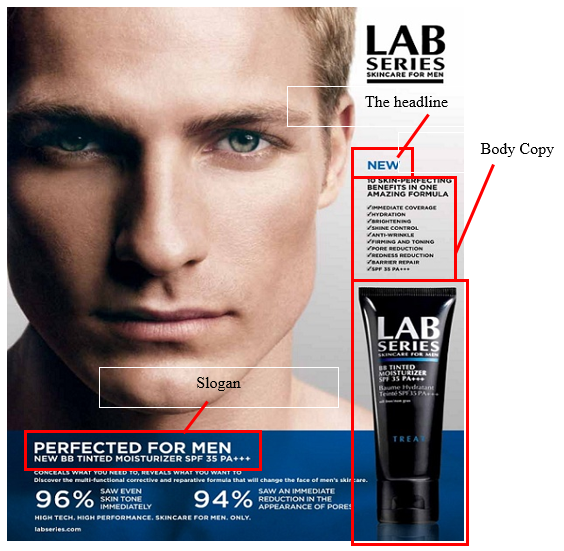Introduction
The suggested semiotic essay is focused on the in-depth investigation of two different ads created by LOreal and Lab Series. The pivotal aim of this paper is the comprehensive analysis of how the brands mentioned above use gender stereotypes and desires peculiar to males and females to create an image that will attract potential customers and spark interest among them. Another research question covered in the paper is the examination of how particular features desired by men and women are represented in media and how they contribute to the creation of an ideal image that inspires people and makes them buy particular products. To answer these formulated questions, we will compare and contrast two ads created by LOreal and Lab…
Main body
The first advertisement under investigation is created by LOreal with the primary aim to popularize daily moisturizers and natural skin tone enhancers for women of different ages who want to correct their skin and add some new shades to it. The company is focused on the creation of specific products for skin and hair care, hair coloring, sun-protection, make-up, etc. LOreal creates products of middle and premium quality which means that the target audience of this ad is comprised of women who have a stable income and who are interested in the world of beauty and fashion. That is why it depicts a glamorous celebrity (Scarlett Johansson) with beautiful hair, make-up, and shining skin. This image could be considered a demanding one as Scarlett looks directly at potential customers trying to persuade them to buy the product.

The second advertising is done by Lab Series, the brand that is focused on manufacturing and distribution of prestige skincare cosmetics for men. For this reason, the central aim of this ad is the demonstration of a new product and its innovative and advantageous character. The firm tries to work with all men regardless of their age and suggests different products. At the moment, it becomes more popular in the USA which means that the given advertising is an attempt to find new customers and popularize the brand. The suggested poster depicts a shave clean man with good skin and no visible pores. In such a way, the company emphasizes the fact that by using their products, all men will look similar and they should obviously buy them.
Slogan Continuing the analysis of these ads, we should speak about different means and connotations used by the companies to attract attention to their products. The headline of the first ad asks a rhetorical question “Is there a superior way to glow?” and immediately answers it “Absolutely.” It is done with the primary aim to attract viewers attention to the body copy which goes directly after the headline and explains the nature of the product and its peculiarities (Barthes, Image – Music – Text 91). There is also a slogan “360 days of body perfection” which sparks the interest in women. In general, its design and the use of the rhetorical question contribute to the increased level of attention devoted to the issue and help to find new customers.

As for the second ad, it uses another design to attract viewers attention. The headline is concise and simple. It states “New.” Then, the body copy outlines the main benefits of a new product “10 skin-perfecting benefits in one formula”. The given format apparently differs from the first one as it is focused on another target audience and uses denotation to list all advantages of the product. A slogan states “perfected for men.” The desired effect is achieved with the help of one-word sentences (Barthes, Mythologies 56). One should also note that the given ad is created in blue and grey colors and this pattern is different from the nude tones of the first advertisement (McAllister and West 47). It seems quite logical as these two posters try to affect representatives of opposite genders (Kress and van Leeuwen 74).
Nevertheless, speaking about methods these pictures use trying to achieve the desired effect, several factors should be mentioned. As for the language, LOreals poster enumerates benefits that could be attained if to use its products. These include a natural glow, superior fragrance, ultra-even application, and specific pearls that add unusual effects to the product. The ad also states “a new body language” to emphasize the fact that a woman using this product will belong to a privileged class. The language is formal and (Kress and van Leeuwen 76). The fact is that women appreciate naturalness, quality, and time (Machin 108). For this reason, designers add the above-mentioned facts in the description and attract women’s attention to them.
Exploring the image of Scarlett Johansson, the company uses hidden connotations to show that even this celebrity likes LOreal and a daily moisturizer and natural skin tone enhancer. At the same time, the high modality is achieved due to the exploration of this photo. Moreover, her pose is relaxed and attractive which contributes to the creation of a specific setting appreciated by customers. Looking at this beautiful woman who could be considered an example of femininity, everyone will associate themselves with her and think that this product will help to be attractive (Einstien 87). In such a way, the ad appeals to emotions (uses pathos) to persuade the audience to buy the product.
As for the Lab Series ad, it explores other connotations. One sees a masculine shaven man with good skin. He is firm, confident, and corresponds to the ideals of handsomeness. It is obviously a demand and high modality picture that grasps attention. Men who look at this picture want to feel these feelings and become confident. The company also uses informative statistics to show that its product helps to reduce the appearance of pores and makes skin better (Goffman 10). This ad offers statistics proving the efficiency of the product which evidences the use of logos, or logical arguments.
Altogether, these two images demonstrate differences in approaches advertisers use to popularize their products among men and women. Nude tones and beautiful and feminine Scarlett Johansson are opposed to cold blue and grey colors combined with a masculine mans face. Due to this approach, different connotations appear (Wall and Rayner 32). Women become attracted by perfect skin, a shadow of success, and attention that could be guaranteed if to use LOreals products. Men want to look courageous and confident (Barthes, Mythologies 45). Thus, we observe divergences in the ways different genders evaluate products and make decisions to buy them.
These also show peculiarities of the Western lifestyle and how men and women understand their masculinity and femininity. These aspects differ from other cultures. For instance, in the UAE, many males have beards which means that other connotations should be used to attract them. The same goes for females in the UAE who like not so sexually explicit images. It means that men and women have different representations in Western and other cultures.
Conclusion
In general, these two ads demonstrate differences in the ways media affects men and women. The first advertisement uses pathos, specific pose, testimonial, and hidden connotations combined with the demanding image affect the audience while Labs poster appeals to logos and denotation to outline benefits of the product and attract mens attention.
Woks Cited
Barthes, Roland. Mythologies. Vintage Classics, 1957.
—. Image – Music – Text. Fontana, 1977.
Einstien, Mara. Advertising: What Everyone Needs to Know. Oxford University Press, 2017.
Goffman, Erving. Gender advertisements. The Macmillan Press, 1979.
Kress, Gunther, and Theo van Leeuwen. Reading Images: The Grammar of Visual Design. Routledge, 2006.
Machin, David. Introduction to Multimodal Analysis. Arnold, 2007.
McAllister, Matthew, and Emily West. The Routledge Companion to Advertising and Promotional Culture (Routledge Companions). Routledge, 2015.
Wall, Peter, and Philip Rayner. Media Studies. Routledge, 2008.